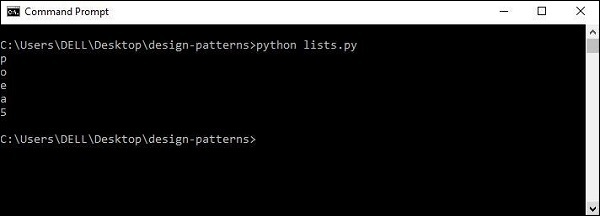
- Python Design Patterns Tutorial
- Python Design Patterns - Home
- Introduction
- Python Design Patterns - Gist
- Model View Controller Pattern
- Python Design Patterns - Singleton
- Python Design Patterns - Factory
- Python Design Patterns - Builder
- Python Design Patterns - Prototype
- Python Design Patterns - Facade
- Python Design Patterns - Command
- Python Design Patterns - Adapter
- Python Design Patterns - Decorator
- Python Design Patterns - Proxy
- Chain of Responsibility Pattern
- Python Design Patterns - Observer
- Python Design Patterns - State
- Python Design Patterns - Strategy
- Python Design Patterns - Template
- Python Design Patterns - Flyweight
- Abstract Factory
- Object Oriented
- Object Oriented Concepts Implementation
- Python Design Patterns - Iterator
- Dictionaries
- Lists Data Structure
- Python Design Patterns - Sets
- Python Design Patterns - Queues
- Strings & Serialization
- Concurrency in Python
- Python Design Patterns - Anti
- Exception Handling
- Python Design Patterns Resources
- Quick Guide
- Python Design Patterns - Resources
- Discussions
Lists Data Structure
The Lists data structure is a versatile datatype in Python, which can be written as a list of comma separated values between square brackets.
Syntax
Here is the basic syntax for the structure −
List_name = [ elements ];
If you observe, the syntax is declared like arrays with the only difference that lists can include elements with different data types. The arrays include elements of the same data type. A list can contain a combination of strings, integers and objects. Lists can be used for the implementation of stacks and queues.
Lists are mutable. These can be changed as and when needed.
How to implement lists?
The following program shows the implementations of lists −
my_list = ['p','r','o','b','e'] # Output: p print(my_list[0]) # Output: o print(my_list[2]) # Output: e print(my_list[4]) # Error! Only integer can be used for indexing # my_list[4.0] # Nested List n_list = ["Happy", [2,0,1,5]] # Nested indexing # Output: a print(n_list[0][1]) # Output: 5 print(n_list[1][3])
Output
The above program generates the following output −

The built-in functions of Python lists are as follows −
Append()− It adds element to the end of list.
Extend()− It adds elements of the list to another list.
Insert()− It inserts an item to the defined index.
Remove()− It deletes the element from the specified list.
Reverse()− It reverses the elements in list.
sort() − It helps to sort elements in chronological order.